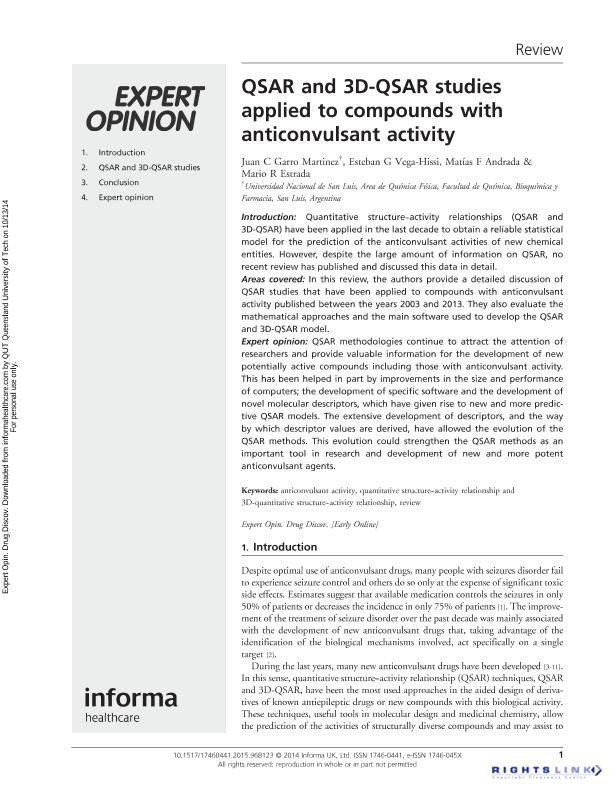Artículo
QSAR and 3D-QSAR studies applied to compounds with anticonvulsant activity
Garro Martinez, Juan Ceferino ; Vega Hissi, Esteban Gabriel
; Vega Hissi, Esteban Gabriel ; Andrada, Matias Fernando
; Andrada, Matias Fernando ; Estrada, Mario R.
; Estrada, Mario R.
 ; Vega Hissi, Esteban Gabriel
; Vega Hissi, Esteban Gabriel ; Andrada, Matias Fernando
; Andrada, Matias Fernando ; Estrada, Mario R.
; Estrada, Mario R.
Fecha de publicación:
09/10/2014
Editorial:
Informa Healthcare
Revista:
Expert Opinion On Drug Discovery
ISSN:
1746-0441
Idioma:
Inglés
Tipo de recurso:
Artículo publicado
Clasificación temática:
Resumen
Quantitative structure--activity relationships (QSAR and 3D-QSAR) have been applied in the last decade to obtain a reliable statistical model for the prediction of the anticonvulsant activities of new chemical entities. However, despite the large amount of information on QSAR, no recent review has published and discussed this data in detail. Areas covered: In this review, the authors provide a detailed discussion of QSAR studies that have been applied to compounds with anticonvulsant activity published between the years 2003 and 2013. They also evaluate the mathematical approaches and the main software used to develop the QSAR and 3D-QSAR model. Expert opinion: QSAR methodologies continue to attract the attention of researchers and provide valuable information for the development of new potentially active compounds including those with anticonvulsant activity. This has been helped in part by improvements in the size and performance of computers; the development of specific software and the development of novel molecular descriptors, which have given rise to new and more predictive QSAR models. The extensive development of descriptors, and the way by which descriptor values are derived, have allowed the evolution of the QSAR methods. This evolution could strengthen the QSAR methods as an important tool in research and development of new and more potent anticonvulsant agents.
Palabras clave:
Qsar
,
3d-Qsar
,
Anticonvulsant
,
Antiepileptic
Archivos asociados
Licencia
Identificadores
Colecciones
Articulos(CCT - SAN LUIS)
Articulos de CTRO.CIENTIFICO TECNOL.CONICET - SAN LUIS
Articulos de CTRO.CIENTIFICO TECNOL.CONICET - SAN LUIS
Articulos(IMIBIO-SL)
Articulos de INST. MULTIDICIPLINARIO DE INV. BIO. DE SAN LUIS
Articulos de INST. MULTIDICIPLINARIO DE INV. BIO. DE SAN LUIS
Citación
Garro Martinez, Juan Ceferino; Vega Hissi, Esteban Gabriel; Andrada, Matias Fernando; Estrada, Mario R.; QSAR and 3D-QSAR studies applied to compounds with anticonvulsant activity; Informa Healthcare; Expert Opinion On Drug Discovery; 10; 1; 9-10-2014; 37-51
Compartir
Altmétricas



